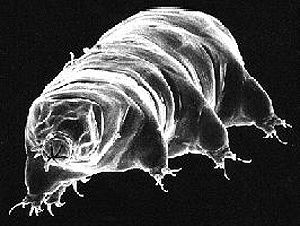-
 Nitrogen cycle
Nitrogen cycle
-
 StarCraft
StarCraft
-
 Launch campaign
Launch campaign
-
 Depressant
Depressant
-
 Brain
Brain
-
 M87
M87
-
 Heterotrophism
Heterotrophism
-
 Magnetic pole
Magnetic pole
-
 Eczema
Eczema
-
 Convergent evolution
Convergent evolution
-
 Inherited
Inherited
-
 Koch Bacillus
Koch Bacillus
-
 Exothermicity
Exothermicity
-
 Apothecary
Apothecary
-
 Thermodynamic temperature
Thermodynamic temperature
-
 Hormone-sensitive
Hormone-sensitive
-
 Water-borne diseases
Water-borne diseases
-
 Refringence
Refringence
-
 Ultraviolet
Ultraviolet
-
 Merlot
Merlot
-
 Oviparous
Oviparous
-
 Vitamin B9
Vitamin B9
-
 Spectrometer
Spectrometer
-
 ReRam
ReRam
-
 Azimuthal mount
Azimuthal mount
-
 Mars Polar Lander
Mars Polar Lander
-
 Ribose
Ribose
-
 Vanograph
Vanograph
-
 Sensitive Natural Space
Sensitive Natural Space
-
 Gametogenesis
Gametogenesis
Tardigrade
From tardus (slow) and gradi (walk). In English, tardigrades are also called water bears. This is a group of small animals, from 50 micrometres to 1.2 mm, with four pairs of short legs. There are 600 known species, found on land (in the soil) or aquatic (fresh water and sea water) and in all climates.
Several characteristics, including the presence of a cuticle, make them similar to arthropods. Under their current classification, they are panarthropods, alongside Onychophora (Peripatus, worms lined with cuticula that have limbs) and euarthropods (arthropods in their true form, notably insects and crustaceans).
Tardigrades are unique due to their exceptional capacity for survival when they enter into a suspended life state of anhydrobiosis or cryptobiosis. They are thus able to resist:
- temperatures near absolute zero and a maximum temperature of 151°C,
- very long freezing periods (tardigrades collected in glacial (core) samples that have remained there for 2000 years returned to life),
- vacuum,
- a pressure of 600 megapascals (the pressure that would be present at the bottom of a hypothetical ocean 60,000 metres deep),
- exposure to X-rays of 570,000 rads (500 rads is the lethal dose for humans).
According to Russian zoologists, tardigrades were able to survive an excursion into space.

Tardigrade seen by a scanning electron microscope. Credits: Rick Gillis and Roger J. Haro Department of Biology / University of Wisconsin - La Crosse
Latest
Fill out my online form.



